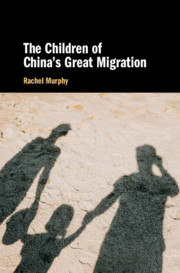Book contents
- The Children of China’s Great Migration
- The Children of China’s Great Migration
- Copyright page
- Contents
- Figures and Maps
- Tables
- Acknowledgements
- 1 Understanding the Lives of Left-Behind Children in Rural China
- 2 Migration, Education and Family Striving in Four Counties of Anhui and Jiangxi
- 3 Sacrifice and Study
- 4 Boys’ and Girls’ Experiences of Distribution in Striving Families
- 5 Children in ‘Mother At-Home, Father Out’ Families
- 6 Children of Lone-Migrant Mothers and At-Home Fathers
- 7 Children in Skipped Generation Families
- 8 Left-Behind Children in Striving Teams
- Appendix: Field Research on Left-Behind Children in China
- Bibliography
- Index
7 - Children in Skipped Generation Families
Published online by Cambridge University Press: 06 August 2020
- The Children of China’s Great Migration
- The Children of China’s Great Migration
- Copyright page
- Contents
- Figures and Maps
- Tables
- Acknowledgements
- 1 Understanding the Lives of Left-Behind Children in Rural China
- 2 Migration, Education and Family Striving in Four Counties of Anhui and Jiangxi
- 3 Sacrifice and Study
- 4 Boys’ and Girls’ Experiences of Distribution in Striving Families
- 5 Children in ‘Mother At-Home, Father Out’ Families
- 6 Children of Lone-Migrant Mothers and At-Home Fathers
- 7 Children in Skipped Generation Families
- 8 Left-Behind Children in Striving Teams
- Appendix: Field Research on Left-Behind Children in China
- Bibliography
- Index
Summary
Chapter 7 explores children’s navigation of their relationship with significant adults in skipped generation families. The analysis adapts Goh’s (2011) concept of ‘intergenerational parenting coalitions’ in seeing the migrant parents and grandparent caregivers as forming ‘multi-local intergenerational parenting coalitions’ - a variant of the ‘multi-local family striving teams.’ Children’s experiences of growing up in multilocal intergenerational parenting teams differed. Children in cohesive families usually received much material and emotional support.But if the middle generation had conflict with the grandparents and remitted little the children could lack nurturing, or alternatively, some children and grandparents clung to each other for solace. Children were usually looked after by paternal grandparents while care by maternal grandparents indicated special family circumstances that impacted on the children’s relationship with caregivers. Children’s closeness to grandparents vis-à-vis migrant parents was also influenced by who they had spent most time with. Even so, all children in skipped generation families enjoyed better relationships with their migrant parents if the two sides interacted regularly. Visits to the city during the school holidays offered many of these children opportunities for interaction with their migrant parents. But the children’s experiences of these visits also varied by the urban lot of their parents.
Keywords
- Type
- Chapter
- Information
- The Children of China's Great Migration , pp. 181 - 214Publisher: Cambridge University PressPrint publication year: 2020

